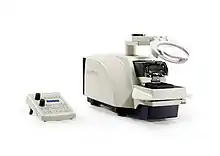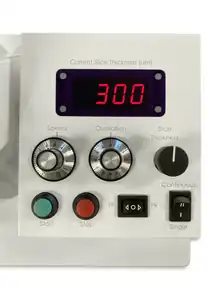
A vibratome is an instrument used to cut thin slices of material (although, usually thicker slices than those cut in paraffin-embedded samples using a microtome). It is similar to a microtome but uses a vibrating blade to cut through tissue. The vibration amplitude, the speed, and the angle of the blade can all be controlled. Fixed or fresh tissue pieces are embedded in low gelling temperature agarose. The resulting agarose block containing the tissue piece is then attached to a metal block and sectioned while submerged in a water or buffer bath. Individual sections are then collected with a fine brush and transferred to slides or multiwell plates for staining.[1]
Vibratome is not a generic name but a registered trademark of Leica Biosystems Richmond, Inc. in the USA.
Use of vibratome
Steps to use microtome are the following:[2]
- Preparing the vibratome
- A vibratome needs be maintained in a clean and functional state, with proper blade mounting and a clean specimen holder.
- Preparing the specimen
- Specimen preparation includes fixation and embedding as needed.
- Adjusting the thickness
- Tissue location and slice thickness must be adjusted properly.
- Cutting the sections
- After activating the blade, it needs to be guided through the tissue
- Cleaning the device
- After using the device, it needs to be properly cleaned.
Advantages
- No need to dehydrate tissues prior to embedding, thus decreased loss of cell constituents
- No messy paraffin embedding
- Allows for agarose embedding of tissue to provide cutting stability
- No need to deparaffinise and rehydrate sections prior to immunostaining
- No high temperatures or harsh chemical treatments that may lead to antigen instability
- No special microtome blades required
- Less chance of artifacts caused by paraffin embedding or freezing
- Decreased tissue autofluorescence due to avoidance of formalin-fixation and paraffin embedding
- Less wait period from tissue sampling to time of immunolabelling
- Allows for direct creation of free-floating sections for immunohistochemistry
Disadvantages
- Instead of ribbons, single sections are cut and collected which are more delicate and difficult to handle.
- Sections are generally thicker than those obtained with paraffin methods; penetration of antibodies and other reagents may be slower and thus longer incubation times may be necessary. Also, thick sections may be difficult to image with the microscope. (However, thick sections are compatible and sometimes even desirable if using confocal microscopy.)
- Securing vibratome sections to glass slides can be difficult or impossible, due to the thickness of the sections.[3]
Experimental Applications
Vibratomes serve a multitude of experimental applications across the life sciences and histology fields.
Electrophysiology
Vibratomes are instrumental in creating live tissue sections, particularly for electrophysiological studies. They enable the preparation of acute brain slices from live specimens, which are essential for techniques like patch-clamp electrophysiology. These slices facilitate the real-time study of neuronal activity and synaptic connections.[4]
Immunohistochemistry
Vibratomes play a crucial role in fixed tissue research by providing precise tissue sections that are vital for immunohistochemistry. These sections are used to visualize and analyze specific biomarkers, proteins, or cellular structures within tissues.[5]
Precision Cut Tissue Slices
Researchers often use Vibratomes to create precision-cut tissue slices, such as precision cut lung slices (PCLS). PCLS are valuable in respiratory research, allowing the investigation of airway reactivity, immune responses, and drug testing in physiologically relevant settings.[6]
Organotypic Slice Cultures
Vibratomes are essential for generating organotypic slice cultures. These cultures maintain the integrity of live tissue slices under controlled conditions, making them ideal for studying tissue development, neuronal circuitry, and various cellular processes.[7]
Availability of the device

Leica Vibratome is a reputable manufacturer known for its precise and reliable Vibratome instruments used in research.[8]
The Compresstome Vibrating Microtome, produced by Precisionary Instruments, is a notable manufacturer in the vibratome market, offering solutions for tissue sectioning, especially when using agarose embedding for enhanced precision.[9]
Other notable vibratome manufacturers are Ted Pella, Inc., Vibratome Company and Campden Instruments Ltd.
In media
Vibratomes appear in many pieces of media, although usually fancified to extravagant proportions. In the Metal Gear franchise (mainly in Metal Gear Rising: Revengeance), "high frequency blades" are utilized by many characters, namely Gray Fox and Raiden. In the Star Wars franchise, vibratomes are featured numerous times in the form of "Vibro-blades".
Gallery
 Vibratome produced by Precisionary Instrument
Vibratome produced by Precisionary Instrument Reading monitor of the device
Reading monitor of the device
References
- ↑ "Improved methods for acute brain slice preparation from adult and aging animals" (PDF). Archived from the original on July 17, 2011. Retrieved June 1, 2009.
- ↑ Abdelaal, Hadia M.; Kim, Hyeon O.; Wagstaff, Reece; Sawahata, Ryoko; Southern, Peter J.; Skinner, Pamela J. (2015). "Comparison of Vibratome and Compresstome sectioning of fresh primate lymphoid and genital tissues for in situ MHC-tetramer and immunofluorescence staining". Biological Procedures Online. 17 (1): 2. doi:10.1186/s12575-014-0012-4. PMC 4318225. PMID 25657614.
- ↑ http://www4.ncsu.edu/~rgfranks/FRANKS%20LAB%20PROTOCOLS/immuno%20histio%20chemistry/robertson%20vbratmimuno.doc%5B%5D
- ↑ Papouin, T.; Haydon, P. G. (2018). "Obtaining Acute Brain Slices". Bio-Protocol. 8 (2): e2699. PMC 5856250. PMID 29552595.
- ↑ Shim, K. (2011). "Vibratome Sectioning for Enhanced Preservation of the Cytoarchitecture of the Mammalian Organ of Corti". Journal of Visualized Experiments (52): 2793. doi:10.3791/2793. PMC 3197053. PMID 21712798.
- ↑ Stinson, Rebecca; Morice, Alyn; Sadofsky, Laura (2021). "Precision Cut Lung Slices (PCLS) Thickness has Limited Impact on Tissue Viability". Airway cell biology and immunopathology. Vol. 58. pp. PA3703. doi:10.1183/13993003.congress-2021.PA3703. S2CID 244673915.
- ↑ Humpel, Christian (2018). "Organotypic Brain Slice Cultures". Current Protocols in Immunology. 123 (1): e59. doi:10.1002/cpim.59. PMID 30311739. S2CID 52966761.
- ↑ "Leica VT1200S Microtome".
- ↑ "New: Precisionary Instruments Compresstome VF-300-OZ » Molecular Pathology Core » College of Medicine » University of Florida".